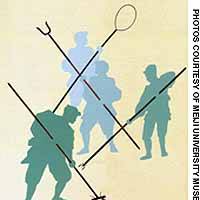This story is part of a package on university museums. To read the introduction, please click here.
It covers only 200 sq. meters and a third of the exhibits are replicas, but Meiji University Museum's display revealing the ferocity of law enforcement in old Japan teaches a history lesson every visitor will remember -- even if many would much rather forget.
Though rather tamely titled "Criminal Materials," the presentation at the university's Surugadai campus in central Tokyo chillingly illustrates how, during both the Edo Period (1603-1867) and the Meiji Era (1868-1912), the authorities in Japan liberally employed torture and execution as tools of social control.
"Visitors study the displays silently," said curator Toru Toyama, who himself speaks in a tone so solemn it's as if he oversees a shrine rather than a museum.
Among the first items encountered is an 18th-century wooden billboard offering rewards from the feudal authorities of the Tokugawa Shogunate for information leading to the arrest of robbers. (Even native Japanese struggle with the archaic text. If you don't speak Japanese, bring a friend who does, as there are few English explanations.)
A criminal sensing he'd been ratted on might take to the hills, but once cornered he'd be lucky to evade a search party equipped with the torimono dogu (tools of arrest) in the next display -- long wooden poles with iron fixtures to immobilize a fugitive putting up a fight. Fearsome and intricate in appearance -- with tiny hooks to entangle kimono sleeves or samurai topknots, and thorny studs preventing the quarry from grabbing the pole -- these implements were in fact designed to speedily immobilize suspects while causing as little injury as possible.
But torture came soon enough. Once in the hands of the law, people accused of serious crimes could expect little in the way of compassion. Their captors wanted a confession, after all, and didn't hesitate to extract it through force.
As we learn, even if tight-lipped suspects managed to get through the preliminary flogging without uttering the magic words -- "osore irimashita (I'm sorry; I did it)" -- they still had to undergo ishidakizeme (pressing by stone), in which they were forced to kneel on sharply ridged platforms while as many as 10 stone slabs, each weighing 55 kg, were piled across their thighs. (A mannequin at the museum is encumbered in just such a way.)
Because many were unable to endure even this early stage of the torture process -- and knew that far worse torment, also depicted, awaited holdouts -- it's a safe guess that not everyone who "came clean" was actually guilty as charged. Murder, arson, and even commiserating with the boss's wife, met with the ultimate penalty.
Like the cowed townspeople of yesteryear, visitors are ghoulishly drawn to the spectacle. The most gruesome punishment shown is a 1869 photograph of a Yokohama execution ground where a band of robber-murderers had just been despatched. In the print, six severed heads -- weirdly, some seem to grin -- are shown posted on a wooden board as a warning to others, while behind them a boy crucified for aiding the robbers slumps from the scaffold where he had been impaled with spears. Said curator Toyama: "Some visitors become queasy and need to take a seat."
The museum estimates that more than 10,000 people, mostly senior citizens and college students, but also some youngsters, traverse the U-shaped interior of the crime-and-punishment exhibit every year.
Some may just be passing between the museum's neighboring sections on traditional handicrafts and prehistoric artifacts. Yet others, particularly those old enough to recall World War II and Japan's kenpei secret police, surely see Meiji University's exhibition for what it is: a reminder that beyond the boundaries of modern jurisprudence barbarism may well be lurking.
Meiji University Museum is a five-minute walk from Ochanomizu Station on the Chuo Line and the Marunouchi subway line. Open 10 a.m. to 4:30 p.m. every day except Aug. 10-16 (and weekends that month), Nov. 1 and Dec. 26-Jan. 7. Last admission at 4 p.m.; entrance free. For further details, visit the museum's (Japanese-only) Web site at www.meiji.ac.jp/museum/info/infoN.htm
For other stories in our package, please click the following links:
Universities put on a show
Bygone botanists bring the past to life
Rural revelations and a sake to go
Drop by and tune in to a world of music
Wherever you may be

















With your current subscription plan you can comment on stories. However, before writing your first comment, please create a display name in the Profile section of your subscriber account page.